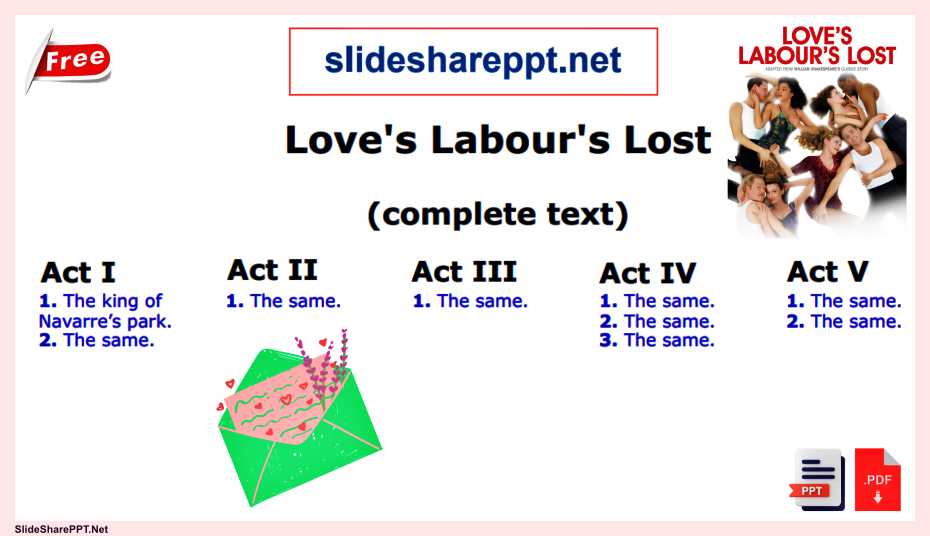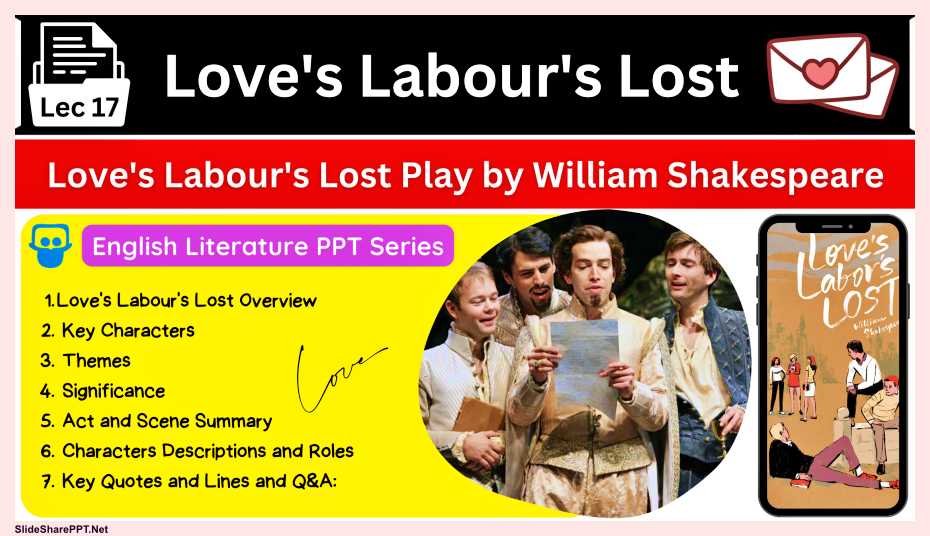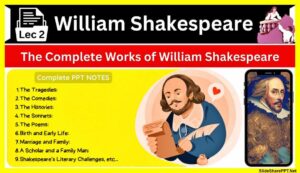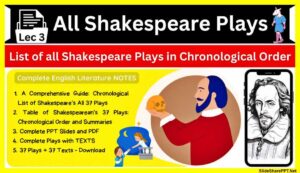Love’s Labour’s Lost PPT Slides & PDF Download
Contents
Today we have shared the Notes – Love’s Labour’s Lost PPT Slides, Love Labour Lost, Love’s Labour’s Lost PDF, and PPT Slides by William Shakespeare PPT Slides & PDF Download, So as we know In the vast tapestry of William Shakespeare’s illustrious works, “Love’s Labour’s Lost” occupies a unique and vibrant place as a comedic gem that intertwines themes of love, wit, and human folly. Set against the backdrop of the Kingdom of Navarre, this early Shakespearean comedy unfurls with a delightful concoction of wordplay, romantic entanglements, and comedic misunderstandings. As the young noblemen of Navarre embark on a journey of scholarly pursuits and solemn oaths to avoid the distractions of love, the arrival of the Princess of France and her retinue sets in motion a series of events that test the boundaries of intellect, desire, and heartfelt emotion. Through intricate dialogue, witty repartee, and timeless insights into the complexities of human relationships, “Love’s Labour’s Lost” continues to captivate audiences and scholars alike, showcasing Shakespeare’s enduring mastery of the comedic form and the enduring allure of love’s timeless dance.
Table of Love’s Labour’s Lost
Here’s a complete table for “Love’s Labours Lost”:
| Aspect | Description |
|---|---|
| Title | Love’s Labours Lost |
| Playwright | William Shakespeare |
| Genre | Comedy |
| Date of Composition | Estimated to be between 1594 and 1595 |
| Setting | The kingdom of Navarre and the surrounding countryside |
| Main Characters | King Ferdinand of Navarre, Princess of France, Berowne, Longaville, Dumaine, Rosaline, Maria, Boyet, Don Adriano de Armado, Moth |
| Plot Overview | The play revolves around the King of Navarre and his lords who vow to forgo the company of women and focus on scholarship. However, their resolve is tested when the Princess of France and her entourage arrive on a diplomatic mission. |
| Key Themes | Love, courtship, wit, and wordplay, the contrast between idealism and reality |
| Significance | “Love’s Labours Lost” is one of Shakespeare’s early comedies and is known for its witty dialogue, intricate wordplay, and exploration of the complexities of love and courtship. |
| Notable Lines | – “They have been at a great feast of languages, and stolen the scraps.” (Act 5, Scene 1) – “The words of Mercury are harsh after the songs of Apollo. You that way: we this way.” (Act 5, Scene 2) – “When icicles hang by the wall / And Dick the shepherd blows his nail.” (Act 5, Scene 2) |
| Adaptations | Various stage productions, film adaptations, and television adaptations have been made over the years. Notable adaptations include Kenneth Branagh’s film adaptation (2000) and stage productions by the Royal Shakespeare Company and other theater companies. |
This table provides a comprehensive overview of various aspects of “Love’s Labours Lost,” including its background, plot, characters, themes, significance, notable lines, and adaptations.
Love’s Labour’s Lost PPT Slides
(PPT Lec 17)
Important:-
- If you are viewing this PPT on your phone, please make it full screen and then view it. (Press: 3 dots in PPT, then Full Screen)
- If you have a problem while clicking on next, (Just tap) on the slide instead of clicking Next Botton.
- FOR A BETTER VIEW PRESS Ctrl + Shift + F ON A PC OR LAPTOP.
- Whatever is written in the PPT is different and whatever is written below is different.

Note: The complete Text PDF Link is at the end of the PowerPoint slides (go to the last PPT Slide)
Love’s Labour’s Lost: William Shakespeare’s Witty Exploration of Love and Wit
William Shakespeare’s “Love’s Labour’s Lost” stands as a testament to the playwright’s mastery of language, wit, and comedic timing. Written in the late 16th century, this delightful comedy follows the romantic entanglements of a group of young noblemen who swear off love in favor of study, only to find themselves ensnared by the charms of a visiting princess and her entourage. Through clever wordplay, farcical situations, and poignant insights, Shakespeare navigates themes of love, intellect, and the follies of youthful idealism.
- The play is set in the Kingdom of Navarre, where King Ferdinand and his three companions, Berowne, Dumaine, and Longaville, pledge to devote themselves to three years of rigorous study, fasting, and celibacy. Their lofty goal is soon challenged when the Princess of France arrives with her ladies-in-waiting, Rosaline, Maria, and Katherine, on a diplomatic mission.
- From the outset, Shakespeare establishes a contrast between the solemn oath of the men and the impending allure of romantic love. The King’s decree creates an atmosphere of artificial restraint, setting the stage for comedic misunderstandings and hidden desires. As the men struggle to reconcile their scholarly ambitions with their newfound infatuations, the play unfolds with sparkling dialogue and clever repartee.
- Central to the comedic elements of “Love’s Labour’s Lost” is the interplay of language and wit among the characters. Shakespeare’s wordplay is on full display as the men attempt to woo the women while adhering to their oath of abstinence. Berowne, in particular, serves as a voice of reason and wit, questioning the practicality of their oath and exposing the hypocrisy of his companions, including the King himself.
- The introduction of comedic subplots involving characters like Costard, a witty rustic, and Don Adriano de Armado, a pompous Spaniard, further enriches the play’s humorous tapestry. Costard’s love affair with Jaquenetta and Armado’s comical posturing provides moments of levity amidst the romantic complications of the main plot.
- As the narrative unfolds, misunderstandings abound, secrets are revealed, and the characters navigate a maze of mistaken identities and hidden emotions. Shakespeare deftly weaves together elements of farce, satire, and romance, culminating in a climactic revelation that exposes the men’s amorous pursuits and leads to public embarrassment and self-awareness.
- Despite its comedic tone, “Love’s Labour’s Lost” also offers insights into the nature of love, learning, and human folly. The characters’ journey from idealistic vows to humbled realization mirrors the complexities of real-world relationships and the inevitable clash between youthful exuberance and mature understanding.
- In the play’s resolution, Shakespeare offers a nuanced portrayal of love’s triumph over intellectual pretensions. The men, having shed their masks of scholarly seriousness, embrace vulnerability and genuine emotion, paving the way for reconciliation and mutual affection with the women they love.
“Love’s Labour’s Lost” endures as a timeless exploration of human desires, aspirations, and the enduring power of love’s allure. Shakespeare’s intricate wordplay, vibrant characters, and insightful commentary continue to captivate audiences, reminding us of the enduring relevance of his works in exploring the complexities of the human heart and mind.
Summary and Act: Love’s Labour’s Lost
Here is a table with a summary of each act in “Love’s Labour’s Lost” that can be helpful for understanding the play’s progression. Here’s a simplified version:
| Act | Summary |
|---|---|
| Act 1 | The King and his companions vow to dedicate themselves to studying and avoiding women for three years. The Princess of France arrives on a diplomatic mission, disrupting their plans and sparking romantic interests despite their oaths. |
| Act 2 | The romantic pursuits intensify as the men try to court the ladies in secret, leading to comedic misunderstandings and witty exchanges. The characters’ conflicting desires and intellectual debates come to the forefront. |
| Act 3 | The themes of love, wit, and deception deepen as the romantic entanglements become more complex. The arrival of a messenger bearing news of the Princess’s father’s death adds a somber note to the comedic proceedings. |
| Act 4 | Revelations and confrontations ensue as the men’s deceptions are exposed, leading to humorous confrontations and moments of self-reflection. The characters navigate the consequences of their actions amidst comedic chaos. |
| Act 5 | The play concludes with resolutions to the romantic entanglements, emphasizing the folly of youthful idealism and the enduring power of love. Themes of reconciliation, forgiveness, and personal growth come to the forefront. |
This table provides a brief overview of each act’s main events and themes in “Love’s Labour’s Lost.”
Themes
Here is a table to summarize the themes of “Love’s Labour’s Lost” which can be a great way to understand the play’s depth and complexity. Here’s a structured table outlining some of the key themes:
| Theme | Description |
|---|---|
| Love and Romance | – Romantic entanglements between the men of Navarre and the visiting ladies – Exploration of courtship, attraction, and love amidst intellectual pursuits |
| Wit and Wordplay | – Shakespeare’s clever use of language, puns, and witty repartee among characters – Humorous exchanges and verbal sparring highlighting characters’ intelligence and humor |
| Intellectualism vs. Emotion | – Conflict between the men’s vows of scholarly dedication and their growing emotional attachments – Exploration of the balance between intellectual pursuits and the human experience of love and desire |
| Deception and Disguise | – Characters engaging in secret courtships and hiding their true feelings – Uncovering of deceptions leading to comedic misunderstandings and revelations |
| Folly of Idealism | – Satirical portrayal of the men’s idealistic oaths and their eventual realization of the limitations of their vows – Critique of youthful naivety and the pursuit of unrealistic goals |
| Reconciliation and Forgiveness | – Resolutions to conflicts through forgiveness and understanding – Themes of growth, maturity, and acceptance as characters navigate the complexities of relationships and personal revelations |
| Gender Roles and Expectations | – Examination of societal expectations and norms regarding love, courtship, and gender roles – Subversion of traditional gender dynamics through characters’ actions and interactions |
| The Power of Language and Speech | – Language as a tool for persuasion, humor, and expression of emotions – Shakespeare’s manipulation of dialogue and rhetoric to convey deeper meanings, emotions, and character traits |
This table provides a comprehensive overview of the major themes explored in “Love’s Labour’s Lost.”
Characters
Here is a table to organize the characters in “Love’s Labour’s Lost” which can be quite helpful. Here’s a structured table outlining the main characters:
| Character | Description |
|---|---|
| King Ferdinand of Navarre | An idealistic ruler who initiates the oath to study and avoid women for three years in favor of intellectual pursuits. He falls in love with the Princess of France. |
| Berowne | Witty and skeptical lord who questions the feasibility of their oath. He falls in love with Rosaline. |
| Dumaine and Longaville | The other two lords who join the King in his oath but eventually fall in love with Katherine and Maria, respectively. |
| Princess of France | Intelligent and charming royal who visits Navarre on a diplomatic mission. She becomes the object of the King’s affections. |
| Rosaline, Maria, and Katherine | Attendants of the Princess who capture the hearts of the lords despite their oath to avoid women. Berowne courts Rosaline, Longaville courts Maria, and Dumaine courts Katherine. |
| Costard | Witty country clown involved in a comedic subplot, including a love affair with Jaquenetta. |
| Jaquenetta | Simple country wench loved by Costard and desired by others, including Don Adriano de Armado. |
| Don Adriano de Armado | Spanish braggart who falls in love with Jaquenetta and engages in comedic wordplay with other characters, notably Moth. |
| Moth | Quick-witted page of Don Adriano de Armado, engaged in playful banter and wordplay. |
| Holofernes and Sir Nathaniel | Pedantic schoolmaster and curate, respectively, involved in the Nine Worthies comedic performances. |
| Dull | Constable who adds to the comedic elements of the play through his interactions. |
| Marcade | A messenger who brings news of the death of the Princess’s father, introducing a somber note amidst the comedic events. |
This table provides an overview of the main characters in “Love’s Labour’s Lost” and their roles within the play.
Significance and Legacy
Here is a table to outline the significance and legacy of “Love’s Labour’s Lost” that can help organize its impact and contributions. Here’s a structured table to highlight these aspects:
| Aspect | Description |
|---|---|
| Historical Context | Written during the late 16th century, likely performed during Queen Elizabeth I’s reign, showcasing Shakespeare’s early comedic prowess. |
| Exploration of Love and Wit | The play delves into themes of love, wit, and human folly, juxtaposing intellectual pursuits with romantic entanglements. Highlights Shakespeare’s mastery of language and comedic timing. |
| Satirical Elements | “Love’s Labour’s Lost” satirizes youthful idealism and strict adherence to intellectual pursuits, offering a humorous critique of human nature and societal norms. |
| Gender Roles Exploration | The interactions between male characters and the Princess of France challenge traditional gender roles in courtship and romance, adding depth to the play’s comedic and thematic layers. |
| Influence on Later Works | While not as widely performed as some of Shakespeare’s other plays, “Love’s Labour’s Lost” remains a notable work in his comedic repertoire, influencing later works that explore the complexities of love, wit, and societal expectations. |
This table provides a concise overview of the significance and legacy of “Love’s Labour’s Lost,” showcasing its impact on Shakespearean comedy and broader literary themes.
Key Quotes and Lines
Here is a table to highlight key quotes and lines from “Love’s Labour’s Lost” that can showcase the play’s memorable dialogue and themes. Here’s a structured table to capture some of these quotes:
| Character | Quote | Act, Scene |
|---|---|---|
| King Ferdinand | “Our court shall be a little Academe, / Still and contemplative in living art.” | Act 1, Scene 1 |
| Berowne | “And when Love speaks, the voice of all the gods / Make heaven drowsy with the harmony.” | Act 4, Scene 3 |
| Princess of France | “A lover’s eyes will gaze an eagle blind; / A lover’s ear will hear the lowest sound.” | Act 4, Scene 3 |
| Rosaline | “From women’s eyes this doctrine I derive: / They sparkle still the right Promethean fire; / They are the books, the arts, the academes, / That show, contain, and nourish all the world.” | Act 4, Scene 3 |
| Don Adriano de Armado | “Well, I will love, write, sigh, pray, sue, groan; / Some men must love my lady, and some Joan.” | Act 1, Scene 2 |
| Jaquenetta | “God comfort thy capacity! I say, thy capacity is of that nature that it is not poor, but suffers under the conciseness of a better.” | Act 1, Scene 2 |
These quotes represent some of the play’s memorable lines spoken by key characters, touching on themes of love, wit, intellectualism, and gender dynamics.

QnA:
Q: What is “Love’s Labour’s Lost” about?
A: “Love’s Labour’s Lost” is a comedic play by William Shakespeare that revolves around the King of Navarre and his companions who vow to avoid the company of women for three years to focus on their studies. However, their plans are disrupted when the Princess of France and her ladies-in-waiting arrive on a diplomatic mission, leading to romantic entanglements and comedic misunderstandings.
Q: Who are the main characters in “Love’s Labour’s Lost”?
A: The main characters include King Ferdinand of Navarre, Berowne, Dumaine, and Longaville (the King’s companions), the Princess of France, and her attendants Rosaline, Maria, and Katherine. Other notable characters include Don Adriano de Armado, Costard, Jaquenetta, and various comedic figures.
Q: What are the central themes of “Love’s Labour’s Lost”?
A: The play explores themes of love and romance, wit and wordplay, intellectualism versus emotion, the folly of idealism, reconciliation and forgiveness, and gender roles and expectations.
Q: What is the significance of the play’s title, “Love’s Labour’s Lost”?
A: The title suggests that the pursuit of love can be seen as a laborious endeavor, with potential for disappointment or loss. It reflects the characters’ struggles with romantic entanglements despite their vows to focus on other pursuits.
Q: How does Shakespeare use language and wordplay in “Love’s Labour’s Lost”?
A: Shakespeare employs intricate wordplay, puns, and clever repartee among the characters, particularly in the banter between the male protagonists and the female characters. This linguistic complexity adds depth to the play’s comedic elements and highlights the characters’ wit and intelligence.
Q: What is the outcome of the romantic entanglements in “Love’s Labour’s Lost”?
A: The play concludes with resolutions to the romantic entanglements, as the characters come to terms with their feelings and reconcile their conflicting desires. Despite the comedic chaos and misunderstandings, there is a sense of growth, maturity, and acceptance among the characters.
MCQ:
Q: Who is the King of Navarre in “Love’s Labour’s Lost”?
A) Ferdinand
B) Philip
C) Henry
D) Edward
Answer: A) Ferdinand
Q: What is the primary reason the King and his companions avoid women in the play?
A) To focus on politics
B) To dedicate themselves to scholarly pursuits
C) To avoid romantic entanglements
D) To follow a royal decree
Answer: B) To dedicate themselves to scholarly pursuits
Q: Which character in “Love’s Labour’s Lost” is known for his wit and skepticism?
A) King Ferdinand
B) Berowne
C) Dumaine
D) Longaville
Answer: B) Berowne
Q: Who are the ladies-in-waiting accompanying the Princess of France?
A) Rosaline, Maria, and Katherine
B) Isabella, Anne, and Margaret
C) Elizabeth, Mary, and Jane
D) Eleanor, Beatrice, and Hero
Answer: A) Rosaline, Maria, and Katherine
Q: Which character in “Love’s Labour’s Lost” delivers the longest word in a line of dialogue?
A) King Ferdinand
B) Berowne
C) Jaquenetta
D) Don Adriano de Armado
Answer: C) Jaquenetta (with the word “conciseness”)
Q: What themes are explored in “Love’s Labour’s Lost”?
A) Love and romance, wit and wordplay, gender roles
B) Politics, betrayal, revenge
C) War, honor, loyalty
D) Magic, fantasy, prophecy
Answer: A) Love and romance, wit and wordplay, gender roles
Q: In Act V, Scene 1 of “Love’s Labour’s Lost,” Costard uses the longest word “honorificabilitudinitatibus.” What is the context of this usage?
A) He uses it to praise the King’s wisdom
B) He uses it to describe his love for Jaquenetta
C) He uses it in a conversation about scholarly achievements
D) He uses it in a comedic situation, showcasing his wordplay skills
Answer: D) He uses it in a comedic situation, showcasing his wordplay skills
Q: What is the meaning of the word “honorificabilitudinitatibus” used by Costard in “Love’s Labour’s Lost”?
A) It means “love at first sight”
B) It refers to the beauty of nature
C) It signifies the quality of being able to receive honors
D) It is a nonsense word with no specific meaning
Answer: C) It signifies the quality of being able to receive honors
The word “honorificabilitudinitatibus” is a Latin-based word that was famously used by William Shakespeare in Act V, Scene 1 of “Love’s Labour’s Lost.” While it may seem complex and lengthy, its meaning can be broken down as follows:
Honorificabilitudinitatibus Meaning:
-
- Honorificabilitudinitas is a Latin word meaning “the state of being able to receive honors” or “the capacity to be honored.”
- -ibilibus is a suffix in Latin that can indicate capability or capacity.
- -tatibus is another suffix that can denote a state or condition.
When combined, “honorificabilitudinitatibus” can be interpreted to mean “the state of being able to receive honors” or “the quality of being honorable.” It reflects a concept related to honor, respect, or recognition.
In the context of the play “Love’s Labour’s Lost,” Costard’s humorous use of this long and complex word adds to the comedic elements and showcases Shakespeare’s playful manipulation of language and wordplay.
Read the Previous Post: The Comedy of Errors by William Shakespeare (PPT & PDF)



